When you start with SEO, especially looking at the traffic coming to your website from Google and other search engines, you’ll very soon set up a Google Search Console account.
When you do this, especially as a novice, you may wonder what Google Search Console can tell you about your website.
This article will answer that question. It will go into detail about what data Google Search Console can give you about your website, and it will also give you short answers as to what Google Search Console is and whether or not it should be classed as an SEO tool for you to use in the future.

Image Credit: ChatGPT
What is Google Search Console?
Google Search Console is a potent tool for SEO professionals, providing a wealth of data and diagnostic information to help them enhance website visibility within Google SERPs.
With over eight years of experience in the SEO industry, I’ve leveraged it extensively to monitor site performance, identify issues like crawl errors and broken links, and understand how users find my websites.
It offers insights into the search queries driving traffic, the mobile usability of pages, and the external links pointing to a site. This allows for informed decision-making and strategy optimisation to improve organic search presence.
It’s using data from Google Search Console, at least in part, that we can get results that look like this:
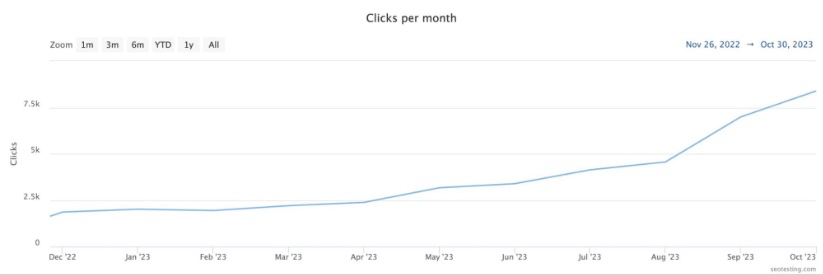
Image Credit: SEOTesting
Is Google Search Console an SEO Tool?
Absolutely.
Google Search Console is a fundamental SEO tool, and nearly a decade in the trenches of SEO has only reinforced my reliance on it. Think of GSC as a direct line to how Google views your website. It does not just show you how to rank or what keywords bring you traffic – although it does this well – it also helps you diagnose issues that could impede your performance in search.
One of the core functions of Google Search Console is its ability to highlight various technical SEO problems, for example, crawl errors or security issues, which can directly impact your website’s visibility. Google favours websites that it can index and understand easily, and GSC is instrumental in ensuring this if you are using it properly.
Google Search Console also excels in performance analysis. It gives you detailed reports on which queries and pages are performing well and which aren’t. For any seasoned SEO specialist or a beginner, these insights are gold. They help us tweak our content and strategy to target keywords and topics. The tool also updates us on how our pages appear in search results through rich snippets or other search features, which can be a game-changer in enhancing click-through rates.
It’s not just about being reactive. GSC allows us to be proactive with our SEO efforts. We can submit sitemaps and individual URLs for crawling, which can be particularly useful after launching new content or making significant site changes.
What Data Does Google Search Console Provide About Your Website?
In this section, we will take you through exactly what data Google Search Console can give you about your website, as well as some small pieces of information as to how you can use this data to your advantage.
Click Data
First and foremost, Google Search Console gives you information about all the clicks coming to your website directly from Google. This includes both normal search traffic and Discover traffic.
You can access this data directly from your GSC dashboard. If you want to get a more detailed view of your click data coming from Google SERPs, head to the Search results tab under the Performance section on the left-hand side of your dashboard:
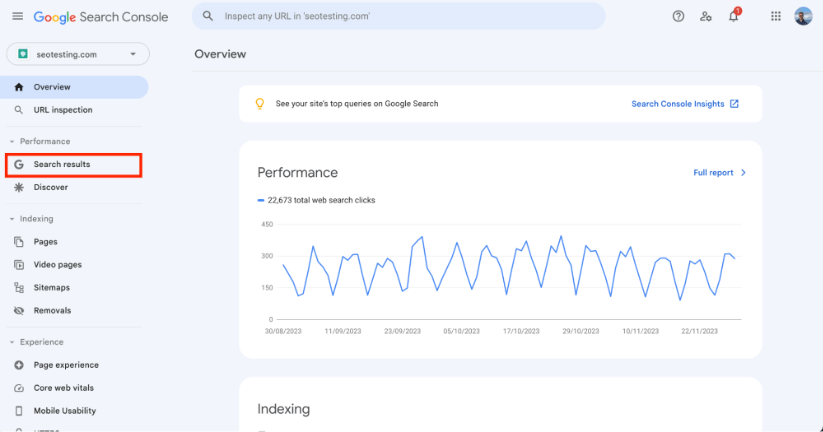
If you want to access information about the traffic your website is getting from Google Discover, head to the Discover section under the Performance tab on the left-hand side of your GSC dashboard:
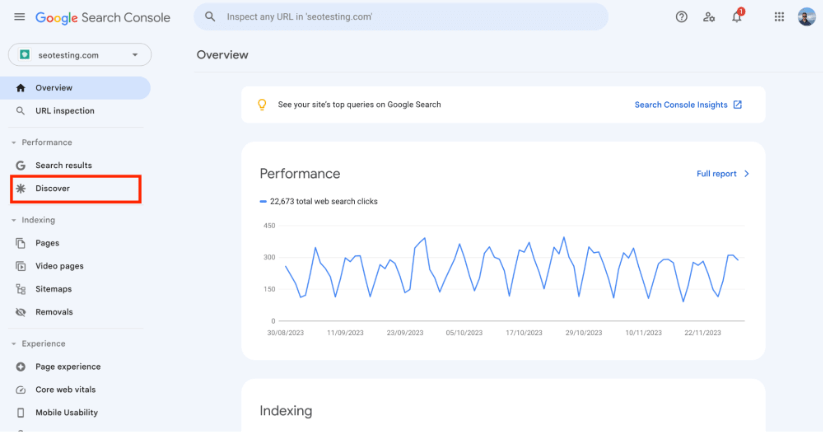
As an SEO professional, you can utilise click data from Google Search Console to identify which pages on your website are performing well in search results and attracting user clicks. This information will help you understand user preferences and search intent, optimising your content and targeted keywords on underperforming pages.
By analysing patterns in click-through rates, you can adjust your SEO strategies to focus on high-performing keywords, improve meta titles and descriptions to enhance click appeal, and align your content more closely with what your audience is actively searching for. This will ultimately drive more organic traffic to your website.
Impression Data
GSC can also give you lots of information about what impressions your website gets within Google search. An impression occurs when a user sees your result within a search but does not click on it.
Head back to your search performance dashboard, and edit the filter so it only shows impressions, and you will be able to get a detailed look at all of the impressions your website is getting within search:
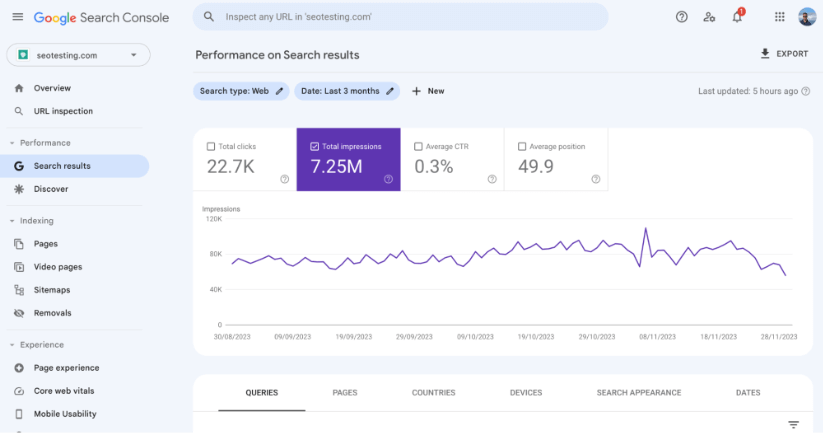
Scroll down within the same report, and you will also be able to see detailed information about which queries and pages are getting the most impressions for your site, which countries give you the most impressions, how many impressions your website receives for different devices, and more!
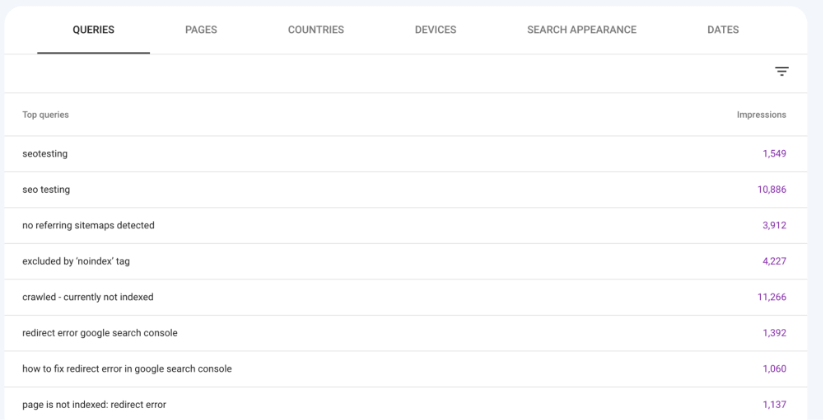
Impression data in Google Search Console is valuable for an SEO professional. By analysing this data, you can identify which queries and pages are most visible in searches, offering insights into your website’s current search engine reach.
This information is critical for uncovering high-potential keywords or topics that may still need to drive traffic but have the potential to do so. You can then optimise your content and SEO strategies around these areas, improving your site’s relevance and authority for these terms.
Additionally, comparing impression data with your click-through rates helps identify gaps where your site is visible but not attracting clicks, guiding content and meta optimisations to enhance user engagement where possible.
Click-Through Rate Data
Google Search Console is a gold mine for click-through rate data on your website. To access this information, do precisely what you did to access your impression data. Open up your search performance report and filter the graph so it shows your CTR data for your website:
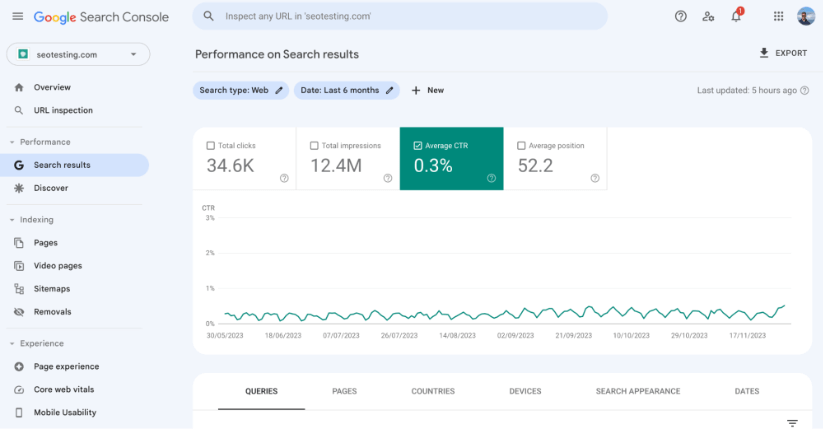
Again, you can also access more detailed CTR data for your:
- Queries
- Pages
- Countries
- Devices
And more. This will help you establish what you need to work on in the future to drive more traffic for pages and queries you already rank well for!
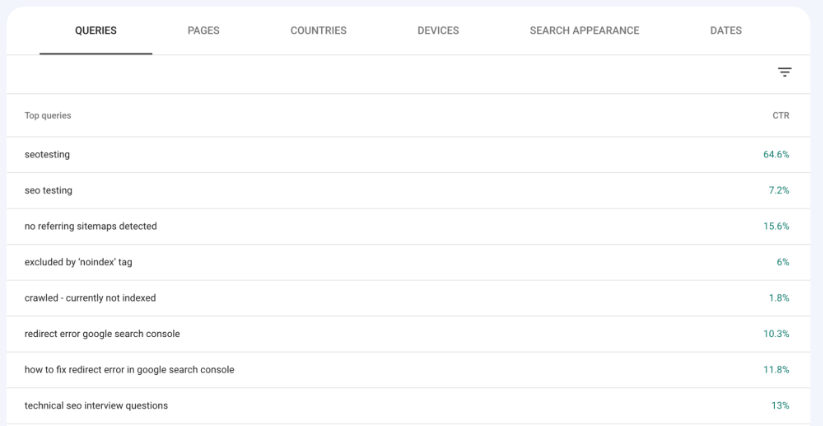
CTR data from Google Search Console is a powerful tool for SEO professionals to gauge the effectiveness of their search results listings.
High CTRs indicate that your titles and meta descriptions are compelling and relevant to the search queries, while low CTRs suggest there is a need for improvement in these areas. By analysing your CTR data, you can identify which pages are underperforming in attracting user clicks despite high visibility. This insight enables targeted optimisations of titles, meta descriptions, and even content to better align with search intent, enhance user engagement, and ultimately increase organic traffic.
Additionally, CTR trends can help you understand user behaviour and preferences, allowing for more informed SEO strategies and better content planning in the future.
Average Position Data
Average position data from Google Search Console is not to be sniffed at. Although it’s generally not as accurate (in terms of fixed positions) as other tools like Ahrefs and Semrush, it’s still beneficial for SEOs to see how their site generally performs within the SERPs.
Access this information like your click, impression, and CTR data. Open up your search performance report and filter the graph so you can see your average position data:
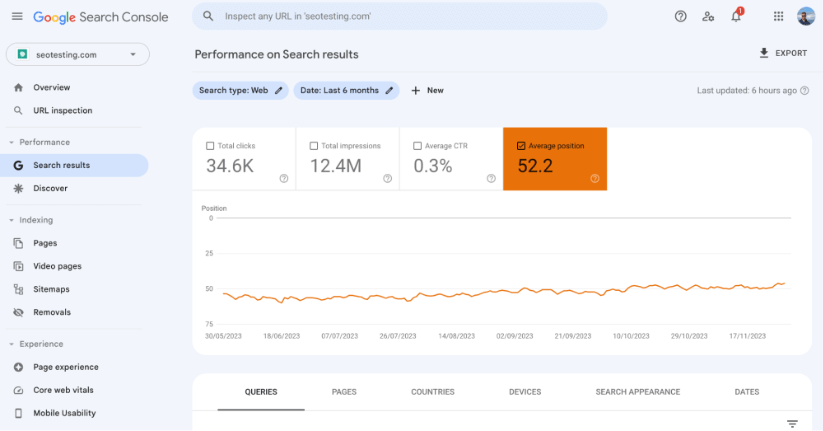
Average position data in GSC is invaluable to SEO professionals, showing where your pages typically rank within Google search results. This metric helps identify pages on the cusp of ranking high, enabling targeted improvements to push them into top positions.
By analysing this data, you can prioritise SEO efforts on pages ranking lower than desired, optimising content, keywords, and on-page elements to boost their rankings. This data also allows you to track the effectiveness of your SEO strategies over time, observe trends, and adjust tactics and strategies accordingly. Focussing on improving the positions of already well-performing pages can also drive additional traffic, as even small increases in ranking can significantly impact visibility and click-through rates.
SEOTesting has a report called Striking Distance Keywords that makes it easy to find these keywords ranking outside page 1.
Page & Video Indexing Information
Google Search Console is also a massive help in researching what pages and videos on your website are being indexed without issue and what pages & videos need help to be indexed. You can do this by accessing your page and video indexing reports from the left-hand side of your dashboard:
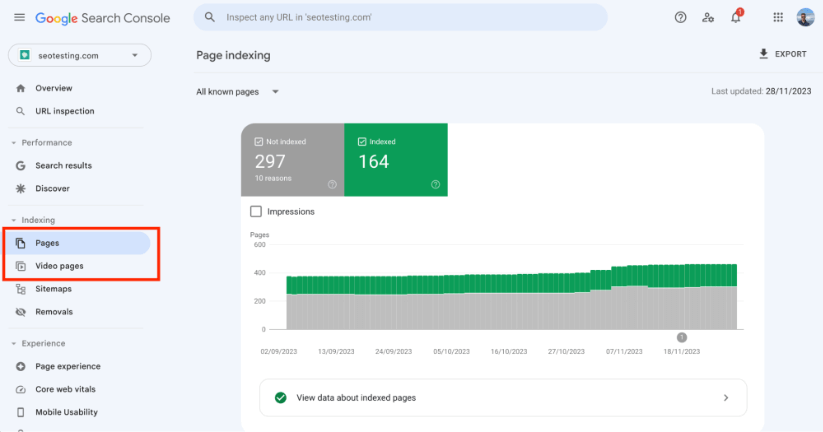
Within these reports, you can see how your site performs on this basis and take appropriate action.
If you scroll further down in these reports, you will be able to see detailed information as to why pages and videos are not being indexed:
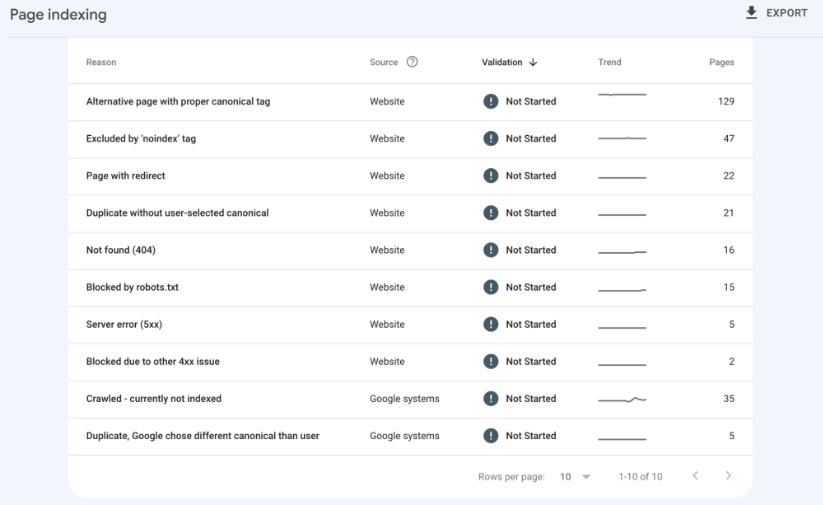
This will allow you to dive into the problems that must be addressed immediately and get your critical pages (and videos) indexed as soon as possible.
These reports help identify and troubleshoot issues, such as pages or videos not being indexed, which could be due to crawl errors, poor SEO practices, or technical issues. By resolving these issues, SEO professionals ensure that all valuable content is discoverable and ranked by search engines.
Additionally, these reports offer insights into the index status of new content, enabling SEO pros to understand how quickly new pages or videos are being indexed and to optimise their strategies for faster and more effective indexing by Google.
Sitemap Information
You will also see a link to your sitemaps report on the left-hand navigation bar of your Google Search Console dashboard. Once you have clicked this, you will see a page that looks similar to this:
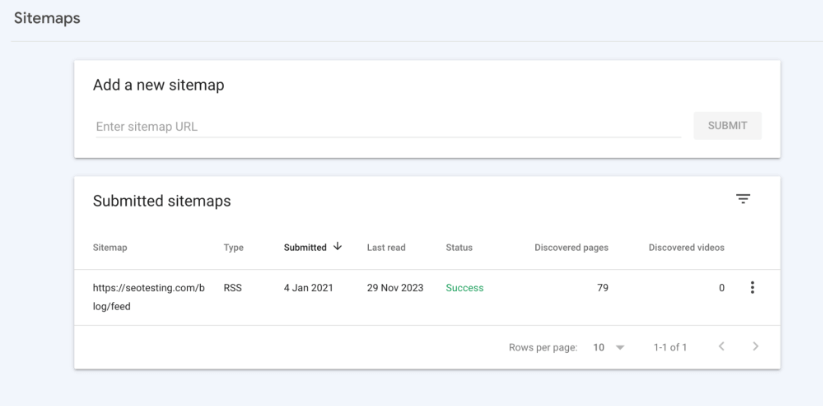
This report will help you track the different sitemaps for your website (if you have more than one) whilst also telling you whether Google has any issues reading them, the number of pages Google has discovered on the sitemap and the URL link to the sitemap itself.
The sitemaps report within GSC is helpful as it enables SEO professionals and webmasters to monitor and ensure that their website’s sitemaps are successfully submitted and processed by Google.
This report provides insights into how many pages from the sitemap are indexed, helping to identify discrepancies between submitted content and what’s appearing in search results.
By regularly reviewing this report, SEOs can quickly detect and address issues with sitemap submissions or indexing, ensuring the website’s content is efficiently crawled and indexed. This is crucial for maintaining the visibility and accessibility of a website’s pages within Google.
Page Experience Information
Within Google Search Console, you can also find your page experience report. We have outlined where to see this within your dashboard in the screenshot below:
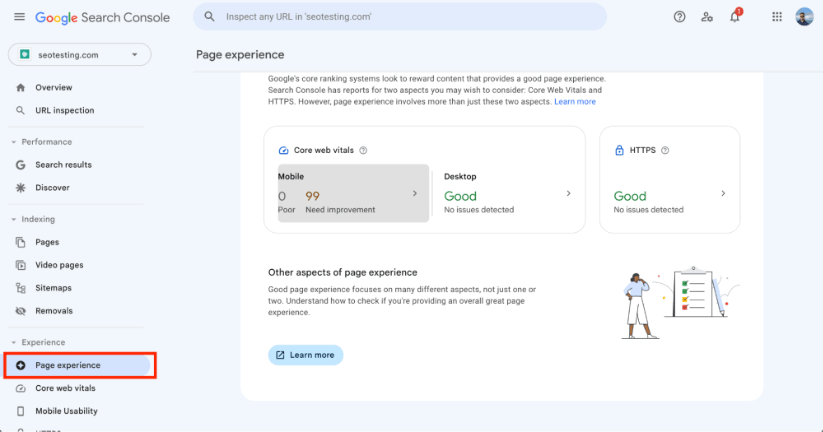
This report is beneficial as it assesses how users perceive the experience of interacting with a web page beyond its pure information value.
The page experience report provides insights into metrics like mobile usability, security issues, Core Web Vitals (loading performance, interactivity, and visual stability), and HTTPS usage. By analysing this data, SEOs can identify and rectify issues that affect user experience, which is a significant (and confirmed) factor in Google’s ranking algorithm. Improving these aspects leads to better user engagement, lower bounce rates, and potentially higher search rankings. Thus enhancing the overall effectiveness of a website in organic search results.
Security Issues & Manual Actions
Regarding security issues, Google Search Console also has a dedicated area within the tool to see more information on whether your site is experiencing any security issues or has had a manual action placed on it.
We have shown you where you can find this information in the screenshot below:
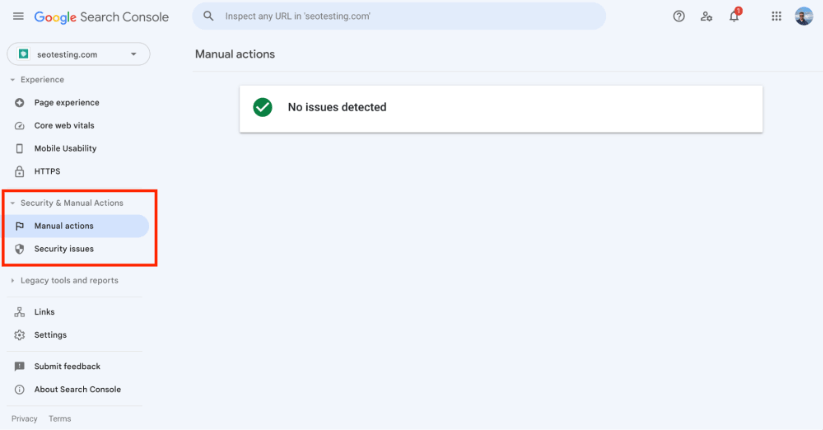
Any manual actions placed on your website or any security issues that Google can find on your site will be shown in these reports.
This section is crucial for helping to maintain a website’s integrity and search performance. It alerts SEO professionals and website administrators to any security threats like hacking or malware and manual penalties imposed by Google due to non-compliance with their Webmaster Guidelines.
Timely identifying and resolving these issues is vital to protect users, preserve the website’s reputation, and prevent potential drops in search rankings. By regularly monitoring this section, professionals can take swift corrective action, ensuring the website remains secure and compliant.
How Long Will Google Search Console Store My Website Data?
GSC retains your website’s data for approx. 16 months. This extensive data history allows SEO professionals and website owners to analyse longer-term trends and make informed decisions based on a comprehensive view of the site’s performance in search results.
This duration covers metrics such as clicks, impressions, CTR, and average position, enabling detailed analysis over time.
By comparing current data to historical data, users can identify patterns, assess the impact of changes or updates made to the website, and strategise future SEO efforts more effectively.
However.
It’s entirely possible that you need this data for longer than 16 months.
If this is the case, you can save this data to another platform like Google Sheets or Microsoft Excel, but if you do not have the time to do this yourself, SEOTesting has this data saved for you. We keep your website’s GSC data for as long as you use the tool, allowing you to have an extensive timeline of your website’s performance in Google. Here’s an example from our website:

This data goes back to April of 2020, nearly four years ago.
In conclusion, Google Search Console is an invaluable tool for SEO professionals, providing a comprehensive suite of data about your website’s performance in Google searches. From click and impression data to insights on page and video indexing and even page experience information, GSC equips you with the information required to enhance your site’s visibility and user experience. Whether you’re a seasoned SEO specialist or just starting, leveraging the power of GSC can lead to informed decisions, strategic optimisations, and, ultimately, improved organic search presence. Remember, while GSC stores data for 16 months, tools like SEOTesting can help you maintain a more extended history for more in-depth analysis.
Want to make more of your Google Search Console data? Give SEOTesting a try. We export your website’s GSC data and create valuable reports for you, all designed to save you time while improving your site traffic. We currently have a 14-day free trial, with no credit card required.

